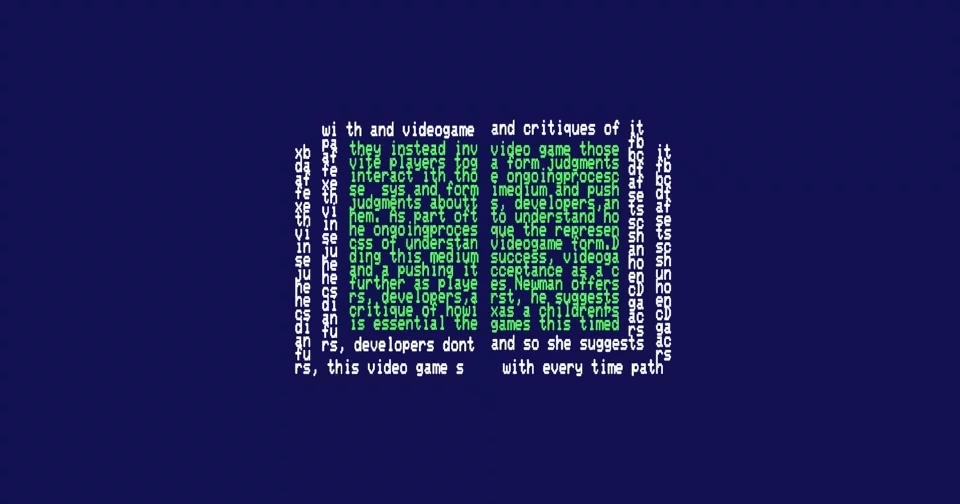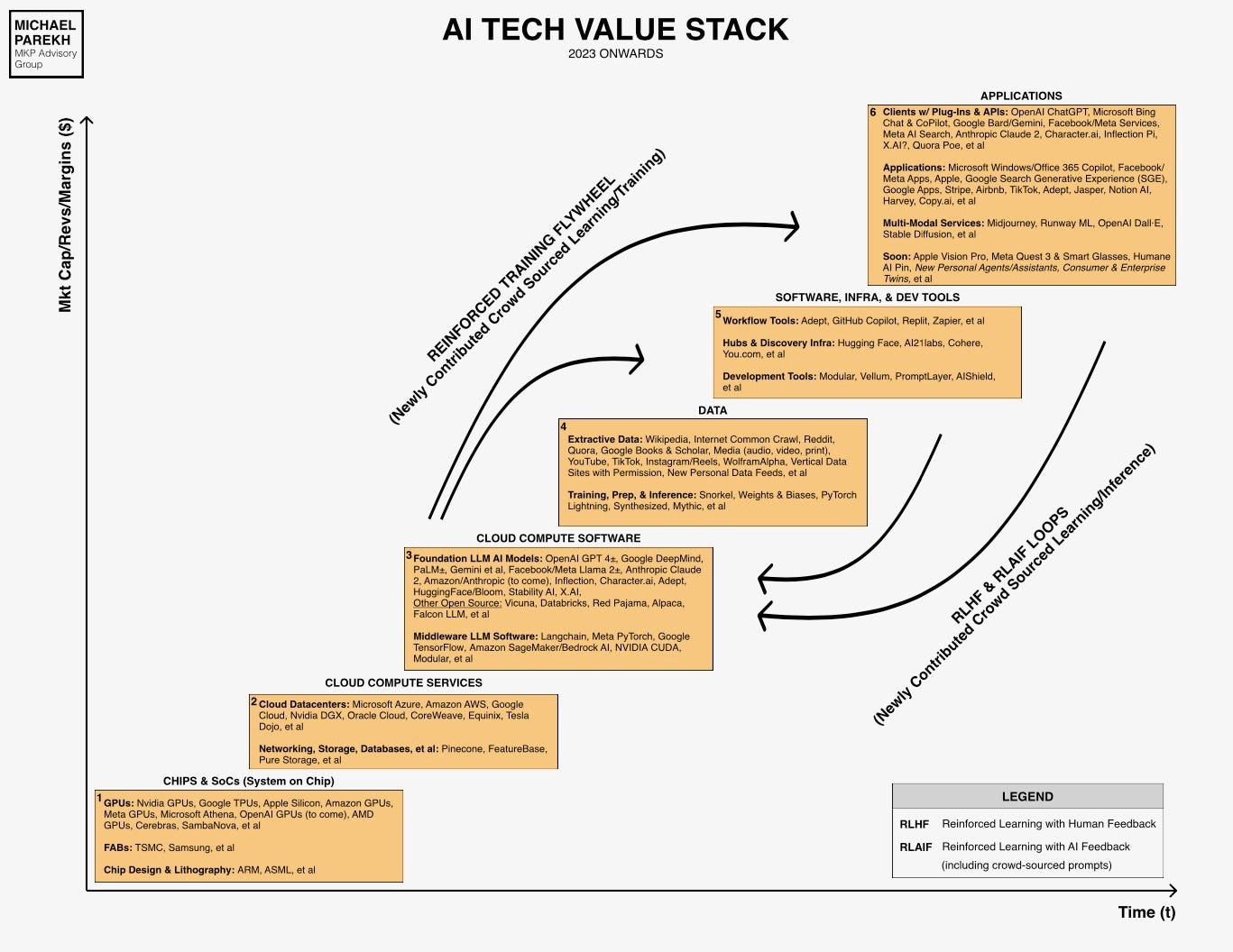AI: The Tech we have vs the Tech we want
...when lesser tech is good enough to build unexpected empires
The Bigger Picture, Sunday October 15, 2023
In this Sunday’s ‘The Bigger Picture’, I want underline that the tech industry is designed and destined to chase new tech organically for its own sake, raising and investing billions in the process. And it more often than not misses on delivering the timetables and scale of the big promises of the new, next, best thing. Often because it takes far longer than initially expected to build the core technologies and infrastructure underlying the ‘tech stack’ of the new tech thing. A lot of incrementally new stuff gets thrown at the wall, and what comes together and really makes a difference at scale in the long run. And it is often very different than imagined and invested in at the beginning of the race. The actual cool new applications and services promised at the end of the rainbow, end up far different than originally imagined. In the meantime, most users end up settling for ‘good enough’ tech, even if the shiniest, newest thing is finally available, kind of, after all that time and money spent (think 5G). As we all jump excitedly on this very promising AI Tech Wave (see chart below) for the next decade and more, we need to really keep this in mind. Let me explain.
Think about the promises made, and then the monetary, human talent, regulatory, and geopolitical capital spent, and global media attention ultimately centered around the shiny, new technology promises just over the last couple of decades: autonomous cars, virtual reality, metaverses, internet for things (IoT), cryptocurrencies, delivery drones, humanoid robots and 5G, to name just a few.
There is a repeating pattern where the tech industry often races after new technology merely for the allure it holds, pouring billions into the furnace of innovation. Yet, the monumental promises that accompany these fresh waves of technology often face the cold, hard reality of building and selling the incremental iterations of the emerging tech. In every layer of tech stacks like above. In all their nooks and crannies.
The core of this discrepancy lies in the enormous resources channeled into crafting the infrastructure for these shiny new promises, often overlooking the prosaic, practical applications and services that just sprout from this tech when deployed at global scale. The result? The majority of users find daily nirvana and life changing utility in ‘good enough’ tech.
Let’s look at some examples of futures imagined and eventually reached. Take autonomous vehicles for instance. The narrative has been painted for over a decade with visions of cities and towns with self-navigating cars, buses and trucks as well as ‘robotaxis’ zipping seamlessly through the streets. Taking us daily to our destinations for the ten percent of the time we actually use the second largest purchase for most households, and sitting idly in parking spots for ninety percent of the time.
Entrepreneurs promising us that these vehicles will go to work for us, earning their keep as it were and actually making their owners money. The promises even propelled some to becoming the ‘richest man in the world’.
Fast forward to today, and what we have is a slow-moving reality where autonomous vehicles are yet to become a daily staple, entangled in a web of regulatory, safety, and technical hurdles. Barely at Level 2 on a scale that goes to 5 where the self driving utopia above lies.
Still out of reach and being promised as being ‘just around the corner’. Instead what we have in most new vehicles is great ‘driver assist’ tech that gets us from here to there a little safer and a bit more convenience, every day. Good enough.
Mind you, you’re reading this from someone who is a life-long tech optimist who believes most of this self driving will ultimately come to pass. Just that the road to these destinations are ever winding and long.
Now, transition your focus onto Virtual Reality (VR) and metaverses. The promise is a digital second place, where we can live alternative lives in lifelike digital realms and ‘realities’. Yet, ever daunting technical realities in dozens of unconnected fields, and the Herculean task of creating ‘win-win’ ecosystems for all parties and data/content providers co to us to delay when we will ‘get there’. Meta, Apple and others will continue to invest billions in the long game, and that is likely a good thing. It’s just that we’re likely to find virtual realities ‘good enough’ in prosaic online communities like Reddit, Roblox, Minecraft and GTA 5 while we wait for the real thing.
In the meantime, we have the humble global adoption of ‘lesser tech’ - technologies that may not have been heralded as a new dawn, but have silently and seamlessly been integrated into our daily routines with life-changing impact.
Consider how the basic internet and the browser, commercialized starting in 1995, still drive out online world today with incremental, under the hood tweaks and evolution. Narrowband and to broadband. Wired to wireless. Desktop to mobile. PC to Cloud. From tens of millions of devices connects to hundreds of millions and now over four billion for a world of eight billion souls.
Think of ‘USB’ devices with their now latest USB-C cables and connectors. Years of evolution to connecting billions of things with now even Apple making lightning fast switches to the global standard (with a little nudging from the EU).
Combine that with ubiquitous Wi-Fi and the omnipresent QR code based payment systems. Just those prosaic technologies have made possible the reality of inter-connected essential gadgets, less expensive wireless broadband, and ubiquitous payment systems especially in developing economies in China, India and Africa. Life-altering for billions.
Then consider Email, ever scrolling text message threads, and endless, personalized notifications on our smartphones. These are the backbones of technology empires like Microsoft (Outlook/Office), Apple (Messages), Salesforce (Slack), Google (Android) and so many more. Modified and tweaked here and there with images, ephemeral messages and short videos, they became the basis of internet empires for Instagram, Snapchat, TikTok, Youtube Shorts, Meta Reels and more.
Finally, consider the decade-long geopolitical hand wringing and wrangling over the promise and national security imperatives around 5G, promising ‘magical’ wireless broadband speeds approaching gigabit speeds equivalent to wired broadband. Again, a decade later and in most countries including South Korea with one of the most advanced 5G networks, and here in the US, we have a technology that for most users is just ‘meh’ when compared to 4G. The applications to take advantage of these speeds are not as yet here.
Again, the point is not that these technologies are not going to be eventually amazing and game changing. It’s just that it takes far longer than we think.
And on the way there, almost every step of the way, in all layers of the tech stack, it is developing technology for technology’s sake. Pieces to chase and move around the board for companies and countries so as not to appear to be falling behind competitors on the ‘The Next Big Thing’.
Spaghetti to throw on the wall and see what sticks. Long, expensive campaigns to find ‘product-market-fit’. Stories to spin dreams around to enthrall and generate FOMO amongst investors private and public.
And it can last for years and sometimes decades without really getting anywhere close to their promise. Like Crypto and Metaverses right now not even at the beginning after over a decade of concentrated focus and investment by countless bright minds.
AI is the next search for ‘El Dorado’ and ‘Fountain of Youth’. I do think we’re going to find amazing utility out of the underlying technologies. Open and Closed. Big and Small. Narrow and wide. The ultimate winning applications and services in Box 6 in the chart above will most likely be very different than the ones we’re dreaming of and chasing right now. Whatever will be will be as the song goes.
It’ll all likely to take much longer than we think. And we’re more likely to find more prosaic and practical aspects of the AI technologies to do amazing things before the amazing things envisioned become amazing realities when we actually think about it.
History keeps reminding us that it’s the ‘good enough’, boring tech that quietly makes colossal realities possible. AI is likely to show the same reality than not. Stay tuned.
(NOTE: The discussions here are for information purposes only, and not meant as investment advice at any time. Thanks for joining us here)







